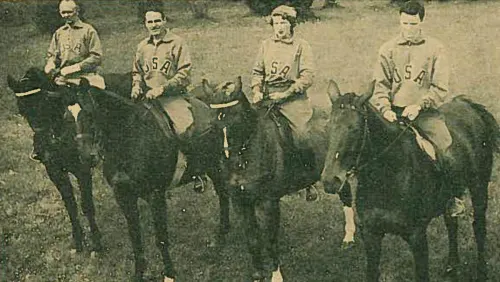We asked an expert what equitation judges expect to see over the fence.
If you’re competing in [the Dover Saddlery/USEF Hunter Seat] Medal, [ASPCA] Maclay Final and [Platinum Performance USEF Show Jumping] Talent Search Finals, you absolutely should be able to do the automatic or following hand as I call it.
Do you need to do that over every fence?
No. I think there are fences [where it’s needed]—for example a short vertical-vertical combination, I want to see the connection, and that’s where an automatic release would come into play. In the advanced level of equitation, riders should be well-educated with this exercise and be able to exhibit the use of the automatic release in the places where it really comes into play.
For me, it’s vitally important, especially in the gymnastics where you’re helping the horse maintain its arc and land balanced. There’s a fine line between following the mouth, by maintaining a connection to the horse’s mouth, and hitting the horse in the mouth and stopping their arc.
ADVERTISEMENT
[Personally, I introduce it with] four crossrail jumps in a row a stride apart—normally 21 feet—with driving reins. So, they hold their hands basically upside down in the reins. No. 1, try not to touch the neck. No. 2, imagine you’re reaching towards the bit with the point of your thumb. This should introduce the idea and timing of independence in the arms.

Top trainer Jim Hagman (right) believes the automatic release or following hand is a skill riders should learn and practice. Photo Courtesy Of Jim Hagman
It should be taught as soon as riders start to become very secure, and they have the ability to be independent and not have to use the neck to rely on for their security and balance. For example in the [USHJA] 3’3″ Jumping Seat Medal for sure, I would like to see independence—[even if it’s] something less than the full automatic release, but it’s getting away from just the crest release.
I think a judge should note it. It should be like high-level figure skating where if you don’t do the triple as a female, you don’t do the quad as a male, you’re not getting plus points. The ability should be evident and used accordingly on the technical aspects of the course.
The hands should have the ability to be independent and not have to touch the neck for balance—I want them below the mane line. The crest release is on top of the mane, like your knuckles can basically touch each other in the braids. In the Medal/Maclay level, I want to see the top junior/amateur eq riders with hands reminiscent of Beezie Madden, Susie Hutchison.
The auto release works as a timing and balance strategy, to help the horse stay over its back legs and elevate higher before they jump outward. That’s the first part. The second part is it shows that you can control where they’re headed in their trajectory towards the landing. In keeping the horse balanced over its hind end, the automatic release works as a tool of communication between horse and rider. When the courses increase in technicality, the horses don’t know where they’re going until we tell them. By executing the automatic release in the highest levels of the equitation, the rider is able to communicate proficiency and sophistication to judges.
ADVERTISEMENT
The timing of it is everything. If you do it too early, you’re stiffing them. If you do it too late, they’ve left the ground; you’re catching them on the peak of the arc or the landing. You must have a cushiony, spongy feel of the mouth off the ground, in the rhythm, as they’re loading up [and] over the fence. The timing and feeling shows the judges: “That rider has really mastered the feeling of how to keep a horse in an arc, how to show the horse where to be in the arc, how to show the horse how to stay in a certain way in its position off the ground so it rocks back and elevates.”
James “Jim” Hagman is the founder and head trainer of Elvenstar Equestrian Center in Moorpark, California. Known for his work with juniors, Hagman got his formal start at the Foxfield Riding School (California). In the last two decades, his students have won the Platinum Performance USEF Show Jumping Talent Search Final—West, R.W. Mutch Equitation Championship, Cacchione Cup and USHJA 3’3″ Jumping Seat Medal—West, as well as at the Capital Challenge Horse Show (Maryland) and Washington International Horse Show (District of Columbia). His riders have also claimed ribbons at the USEF Hunter Seat Medal Final, ASPCA Maclay Final and the WIHS Equitation Final. He’s a clinician for the Stanford University (California) equestrian team and serves on the USHJA Equitation Task Force, the steering committee for the new USHJA Instructor Credential and the USHJA Hunter Working Group.
This is part of a longer article that ran in the Nov. 23 – Dec. 7, 2020, issue of The Chronicle of the Horse in our Equitation Issue. To see the full article with additional thoughts from judge Robin Rost Brown and Olympian Peter Wylde, please subscribe.
Subscribers may choose online access to a digital version or a print subscription or both, and they will also receive our lifestyle publication, Untacked. Or you can purchase a single issue or subscribe on a mobile device through our app The Chronicle of the Horse LLC.
If you’re just following COTH online, you’re missing so much great unique content. Each print issue of the Chronicle is full of in-depth competition news, fascinating features, probing looks at issues within the sports of hunter/jumper, eventing and dressage, and stunning photography.
What are you missing if you don’t subscribe?














